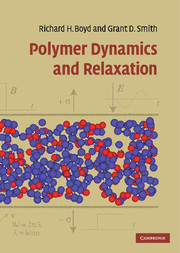Book contents
- Frontmatter
- Contents
- Preface
- Part I Methodology
- Part II Amorphous polymers
- 6 The primary transition region
- 7 Secondary (subglass) relaxations
- 8 The transition from melt to glass and its molecular basis
- Part III Complex systems
- Appendix AI The Rouse model
- Appendix AII Site models for localized relaxation
- Index
- References
6 - The primary transition region
Published online by Cambridge University Press: 10 November 2009
- Frontmatter
- Contents
- Preface
- Part I Methodology
- Part II Amorphous polymers
- 6 The primary transition region
- 7 Secondary (subglass) relaxations
- 8 The transition from melt to glass and its molecular basis
- Part III Complex systems
- Appendix AI The Rouse model
- Appendix AII Site models for localized relaxation
- Index
- References
Summary
Mechanical relaxation
Scope of relaxation
Although the primary transition temperature in a given polymer tends to be similar whether studied mechanically or dielectrically the characteristics in detail are quite different. The mechanical modulus eventually falls to zero with time at higher temperatures. If the molecular weight is above the entanglement length, the rubbery plateau region intervenes before the viscous flow region and the ensuing complete decay toward zero. However, the modulus in the plateau region is orders of magnitude less than the glassy modulus. Thus the mechanical relaxation is characterized by a large modulus change that is best represented by a logarithmic scale for modulus (as in Figure 1.9 for example). Because of the large range over which the modulus decay may be measured the time scale is also extremely wide. It is actually far too wide to be captured directly experimentally. In fact, in a single apparatus, mechanical measurements are usually restricted to a few decades of time or frequency. However, by measuring time or frequency responses at a number of temperatures various parts of the overall relaxation from the glassy to the rubbery state may be captured. Figure 6.1 shows a particularly elegant set of such data [1] in which the storage compliance of poly(n-octyl methacrylate) is plotted against log frequency at a number of temperatures. The complete transition region may then be described in alternative ways.
- Type
- Chapter
- Information
- Polymer Dynamics and Relaxation , pp. 83 - 119Publisher: Cambridge University PressPrint publication year: 2007

